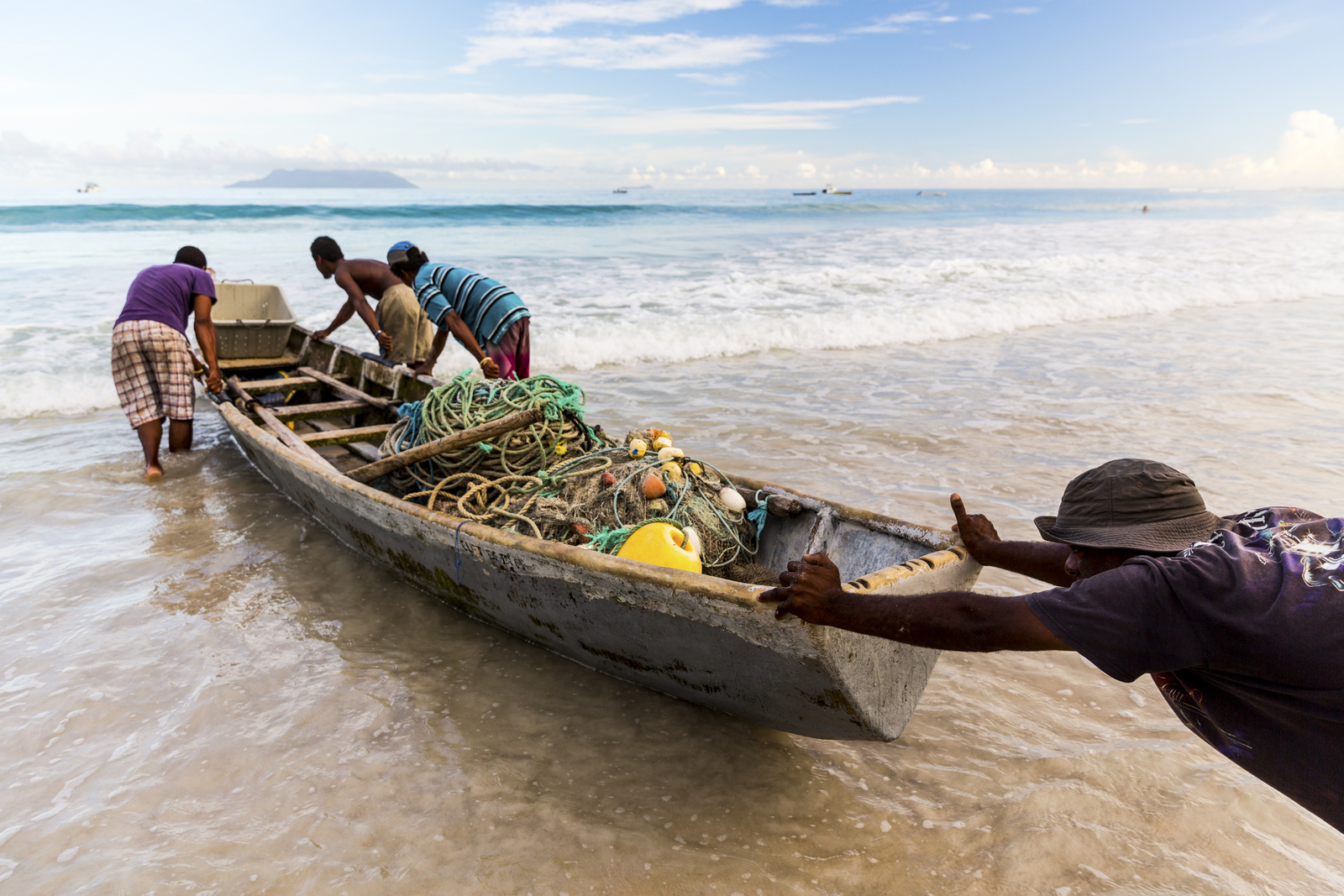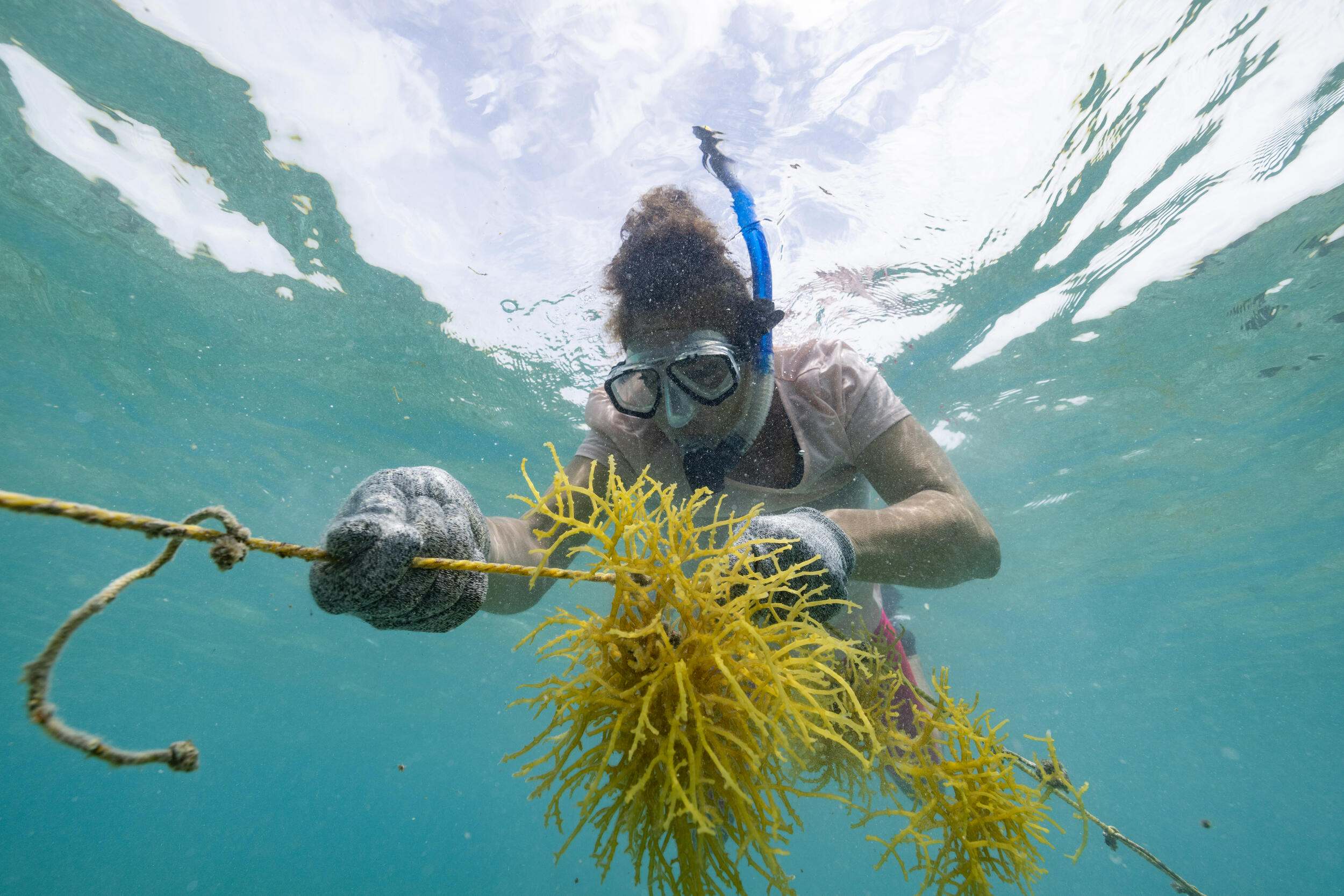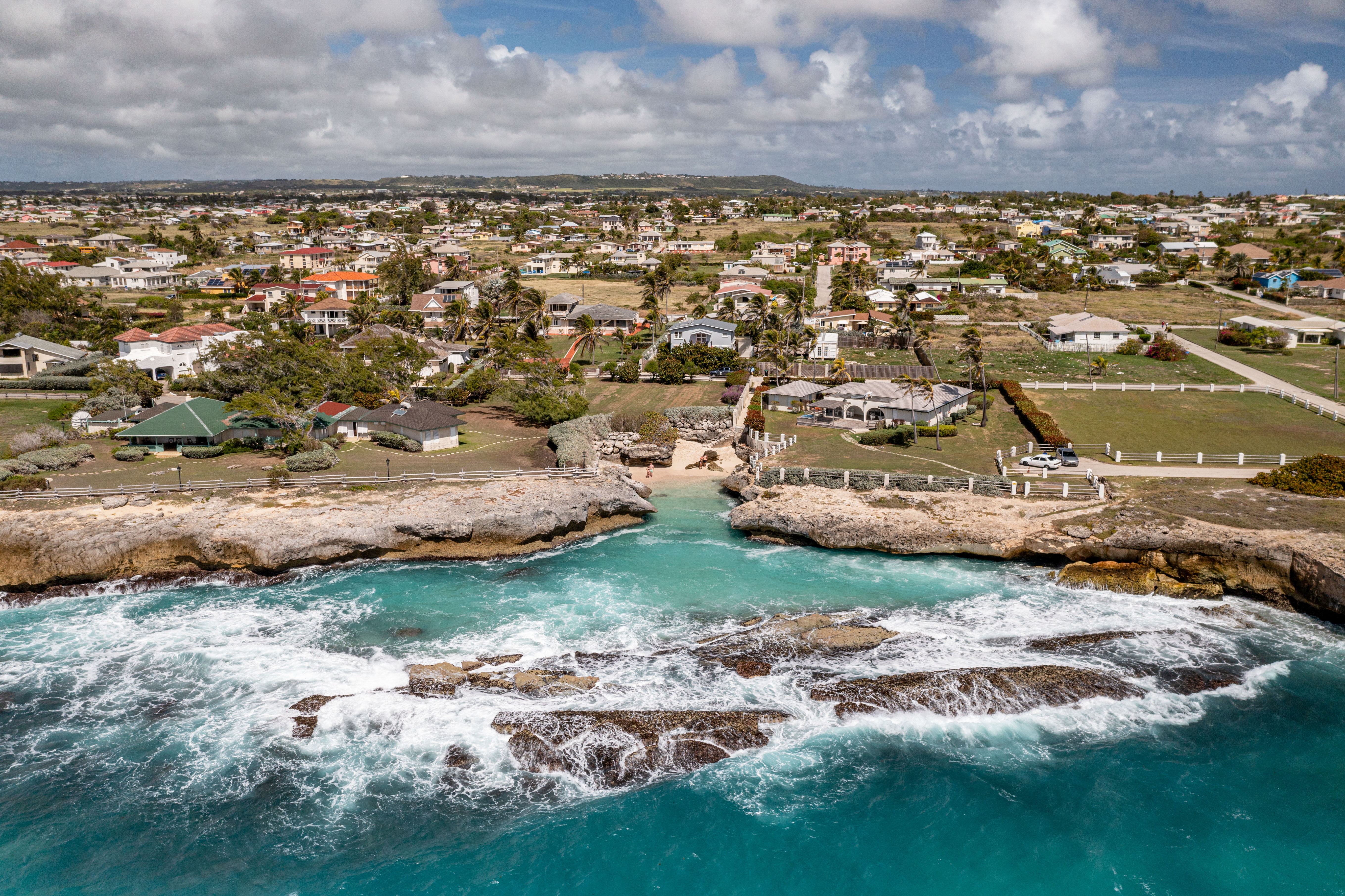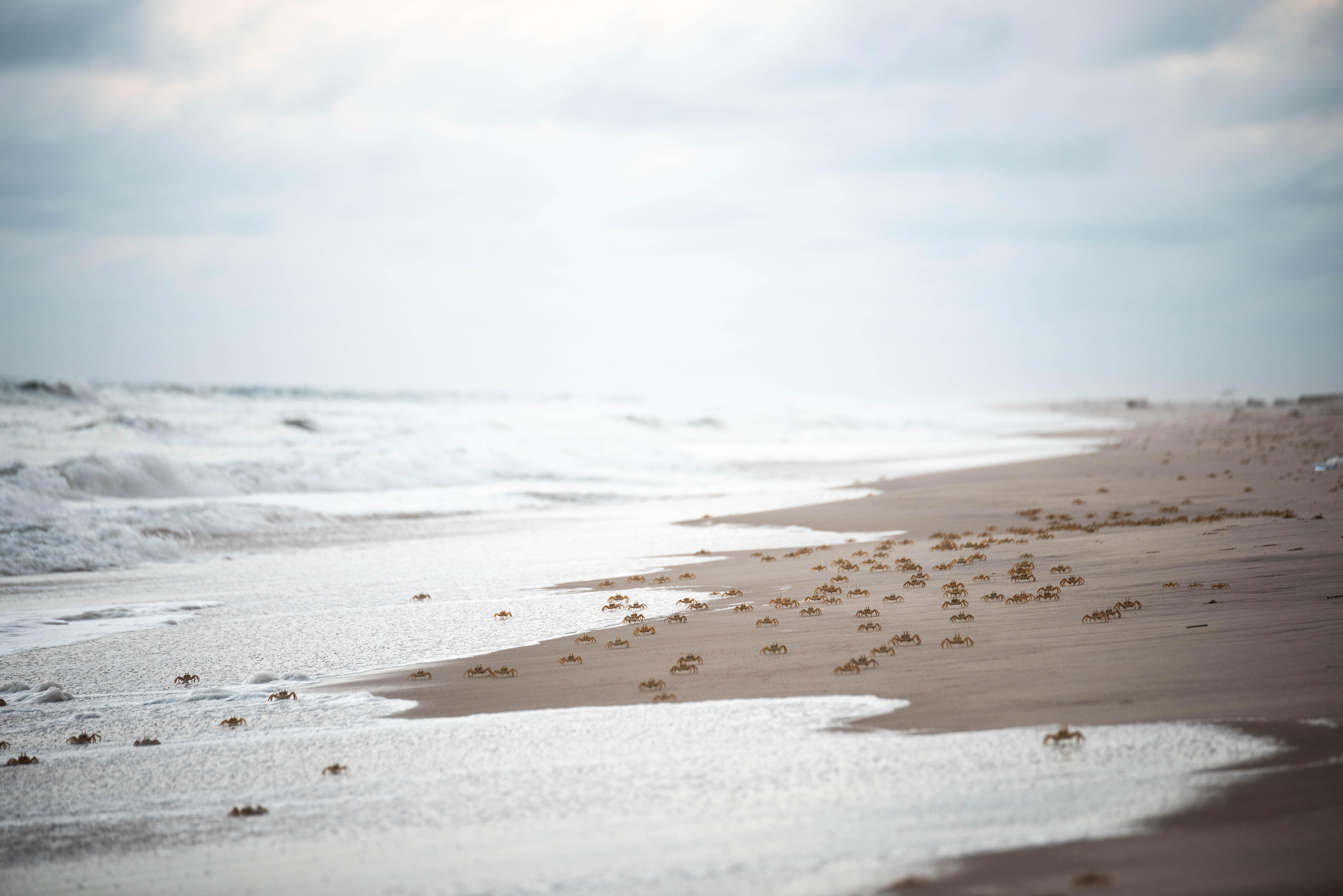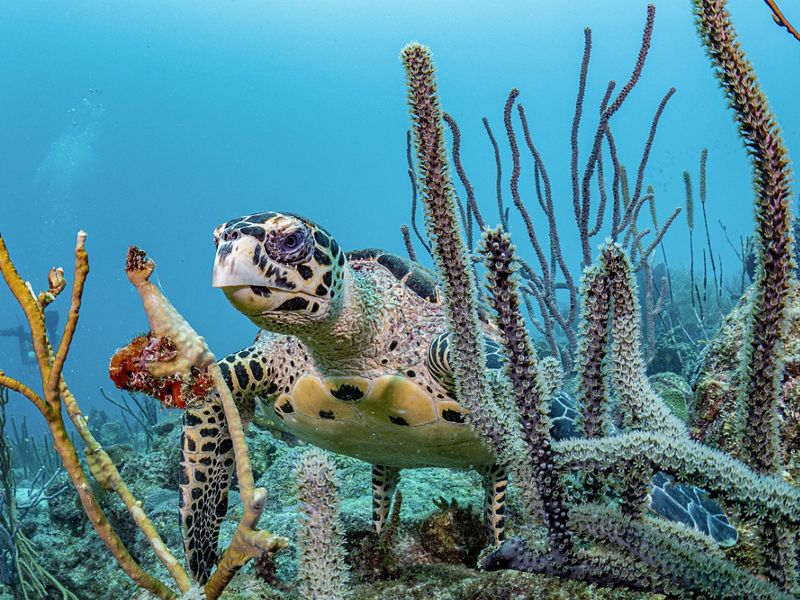
Reef Hero Hawksbill sea turtles are an important part of Caribbean reef ecosystems. Without the turtles grazing, reefs could become overrun by sea sponges. © Shane Gross
Caribbean nations are often referred to as “small-island states.” But in Barbados, many people refer to their country as a “large-ocean state.”
As a child, long before he became a leader in Barbados’ fishing community, Anderson “Rogie” Kinch would watch his neighbors’ boats return from fishing and moor in Oistins Bay. Then he would swim out to the boats to get what people locally call “grub”—the part of the catch that fishermen would hold back for family and neighbors—which he would take home for a “cook-up,” a kind of stew made with rice and peas.
“There was a lot of love,” he said in an interview before his death in June. “And everyone had a connection with the ocean, even if you’d never been to sea yourself.”
That’s still true for most people here. Barbados is the most easterly Caribbean island; so easterly, in fact, that it sits entirely in the strong waters of the Atlantic. While its total landmass is only 166 square miles, roughly half the size of greater New York City, its maritime space is 430 times bigger—about the size of Florida. Caribbean nations are often referred to as “small-island states,” but in Barbados, many people refer to their country as a “large-ocean state.”
Barbadians’ connection with the sea manifests itself in myriad ways. For many people, a plunge in the ocean, or the “sea bath,” is a daily ritual. And fish nourish Barbados: The national dish, cou-cou and flying fish, consists of a fish stew served with a polenta-like concoction of cornmeal and okra. The ubiquitous “fish cutters”—inexpensive yet filling sandwiches—sustain working-class Barbadians across the island.

But Barbados’ relationship with its piece of the Atlantic goes far beyond flying fish. In 2018, just before COVID-19, 1.36 million tourists visited Barbados annually to relax on the beaches, snorkel and dive the reefs, go on catamaran cruises, and surf and parasail. By some estimates, the tourism industry accounts for as much as 31% of GDP—and 33% of jobs—in the country.
“There’s a huge tourism industry that’s based on beautiful beaches and sea turtles,” says Steve Schill, TNC’s lead scientist for the Caribbean. “The ocean is everything. It’s really the engine of the economy.”
What’s a Blue Bond?
An innovative financial mechanism is enabling countries to restructure their national debt and invest the savings into marine conservation.
Funding a Sustainable Future in Barbados with Blue Bonds
Last year, TNC and the Inter-American Development Bank supported a debt conversion by the government of Barbados. As part of TNC’s Blue Bonds for Ocean Conservation program, this project allowed the country to reduce its international debt and will direct an estimated $50 million into a comprehensive marine protection effort. TNC's work on this transaction was supported by 10 families and philanthropic organizations. Barbados’ total maritime zone is a gigantic wedge-shaped tract of water that extends west into the Caribbean and 200 nautical miles east into the Atlantic. It includes everything from coastal reefs with complex ecosystems to the open ocean that’s home to migratory species including marlin, mahi-mahi and yellowfin tuna. Barbados’ maritime zone is nearly 72,000 square miles, and the government plans to protect as much as 30% of it.
“Barbados is so far out there away from the eastern Caribbean chain that there’s a lot of deep ocean,” says Schill. He adds that it is exciting to see the country commit to sustainably manage its maritime zone.
Yet the initiative “is not about drawing lines in the water,” says the University of West Indies’ Patrick McConney, who together with a team at the Centre for Resource Management and Environmental Studies is working with TNC to support the government in its marine planning process. “It’s about compatible uses and crafting policy that includes all of the sectors with a stake here.” And in many ways, the effort will offer a forum for a wider discussion of how to sustain all the different ways the ocean is important to Barbadians, far into the future.
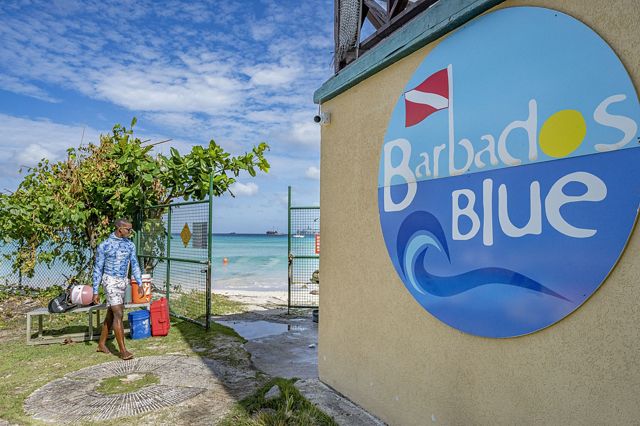
Putting environmental sustainability at the center of finance reform
The concept behind the Barbados Blue Bonds for Ocean Conservation is a debt-for-nature swap, an idea first tested in the 1980s: A country can negotiate an exchange of high-interest loans for lower-interest ones, essentially like refinancing a home. The nation commits to using the savings in interest payments to fund conservation efforts within its borders. The tool was initially developed to protect tropical forests, but TNC has helped pioneer its use in the protection and conservation of ocean habitats. In 2018, TNC announced the first such agreement with the Indian Ocean nation of Seychelles; in 2021, it launched a second one with Belize, in Central America.
The World’s First Blue Bonds
Since 2020, TNC has worked with four countries to design and implement debt swaps for ocean conservation. Learn more in these related articles.
Related Projects
No results are shown. To see results, turn on the toggle switches in the legend.
- Seychelles
-
Seychelles
This “large-ocean nation” off the coast of Africa announced the first Blue Bond on March 26, 2020.
- Belize
-
Belize
In 2021, Belize became the first country in the Americas to finalize a debt conversion for ocean conservation. That commitment enabled Belize to restructure approximately US$550 million of external commercial debt—an amount that represented 30% of the country’s GDP—and reduce the national debt by 12%.
- Barbados
-
Barbados
In September 2022, Barbados struck a deal to leverage $50 million in funding to help protect the nation’s marine ecosystems, support communities and sustainably develop its blue economy.
- Gabon
-
Gabon
On August 14, 2023, Gabon announced the latest Blue Bond for Ocean Conservation. This historic US$500 million project has helped refinance part of Gabon’s national debt and unlocked $163 million to protect and manage the country’s ocean territory.
In Barbados, TNC found a natural partner. Mia Mottley took office as the country’s first female prime minister in 2018 and was determined to tackle the country’s finances. But there was more. “We put environmental sustainability at the center of the reform of the public finances,” says Ryan Straughn, Barbados’ finance minister. And, he adds, “it has evolved very quickly into, how are we going to use the building of climate resilience as an element to drive sustainable growth?”
Barbados will direct the $50 million in interest-payment savings into the newly created Barbados Environmental Sustainability Fund, as an endowment to allow the fund to operate in perpetuity. The fund is overseen by an 11-member board that is charged with evaluating and funding proposals for conservation, climate-resilience and sustainable development projects.
Gregory Hinkson, the principal consultant and managing director of SAMDOR, a Barbados-based financial advisory firm, is the chair of the fund. He likens it to a green version of the long-running reality show Shark Tank, which provides seed money to promising ideas. “You often need that little push to move the idea forward,” he says, “because without that, you never know what it will turn into.”
Developing the first 5-year marine spatial plan for Barbados
But roughly half of the fund’s money is earmarked for a much bigger undertaking: creating a marine spatial plan for Barbados’ entire exclusive economic zone (EEZ). That effort, which will unfold over five years, will combine scientific knowledge with a broad, public participatory effort to develop a plan for how various parts of the country’s marine territory are managed and what areas should receive protection.
“The marine spatial planning is a critical component of the blue bond,” says Straughn. “Until now, we haven’t taken a comprehensive look at our resources throughout the entire EEZ and thought about how we manage the resources for the long-term benefit of the country.”
The marine spatial-planning process will bring together stakeholders from many economic sectors, including fishing and fish processing, seaweed and fish farming, tourism and diving, oil-and-gas development, and renewable energy. With these stakeholders, the government will lead the development of ecological, economic and sociocultural goals and objectives for the marine spatial-planning process. They will create a map of ecologically significant areas in Barbadian waters, overlay that with the areas that are important to various sectors, and then work to resolve conflicts so marine protection and resource use can be balanced to the greatest extent possible.
“Marine spatial planning is all about bringing the stakeholders together and asking: What is your vision for the future? What are the conflicts that you can help us identify? What are your values? And let’s listen to your voice,” says TNC’s Schill.
“There will be some hard negotiations, I’m sure,” says Shelly-Ann Cox, Barbados’ chief fisheries officer. “But it’s only when we have these difficult conversations and discussions that we find a clear balance.”
For all its technical aspects, the marine spatial-planning process offers a chance to create a vision that melds the many aspects of Barbados’ environment, economy and identity.
“I think it’s going to be a tool for figuring out how Barbados keeps moving forward,” says Allison Wiggins, a deputy project manager with the Coastal Zone Management Unit, which will be leading the process. “And I think it’s going to be a way to show the world that a small island with scarce resources can do this major work largely on its own, with help from partners like TNC. But even more than that, I think it’s a way to show the world what is best about Barbados.”
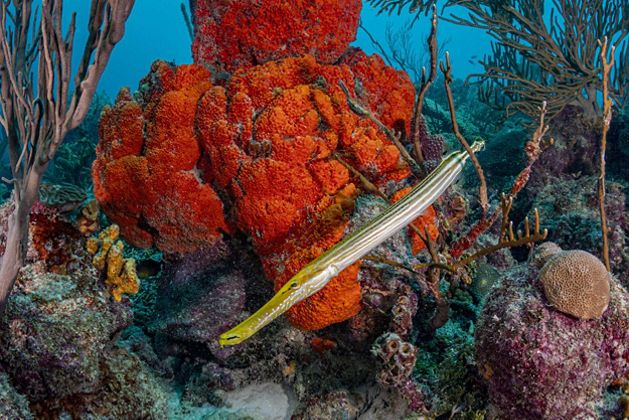
Magazine Stories in Your Inbox
Sign up for the Nature News email and receive conservation stories each month.
About the Creators
Matt Jenkins is a writer and former Nature Conservancy magazine editor who has written for The New York Times, Smithsonian and other publications.
Shane Gross is a Canadian marine photojournalist whose work has appeared in The Globe and Mail newspaper, Smithsonian, Hakai Magazine and Photo Life.
